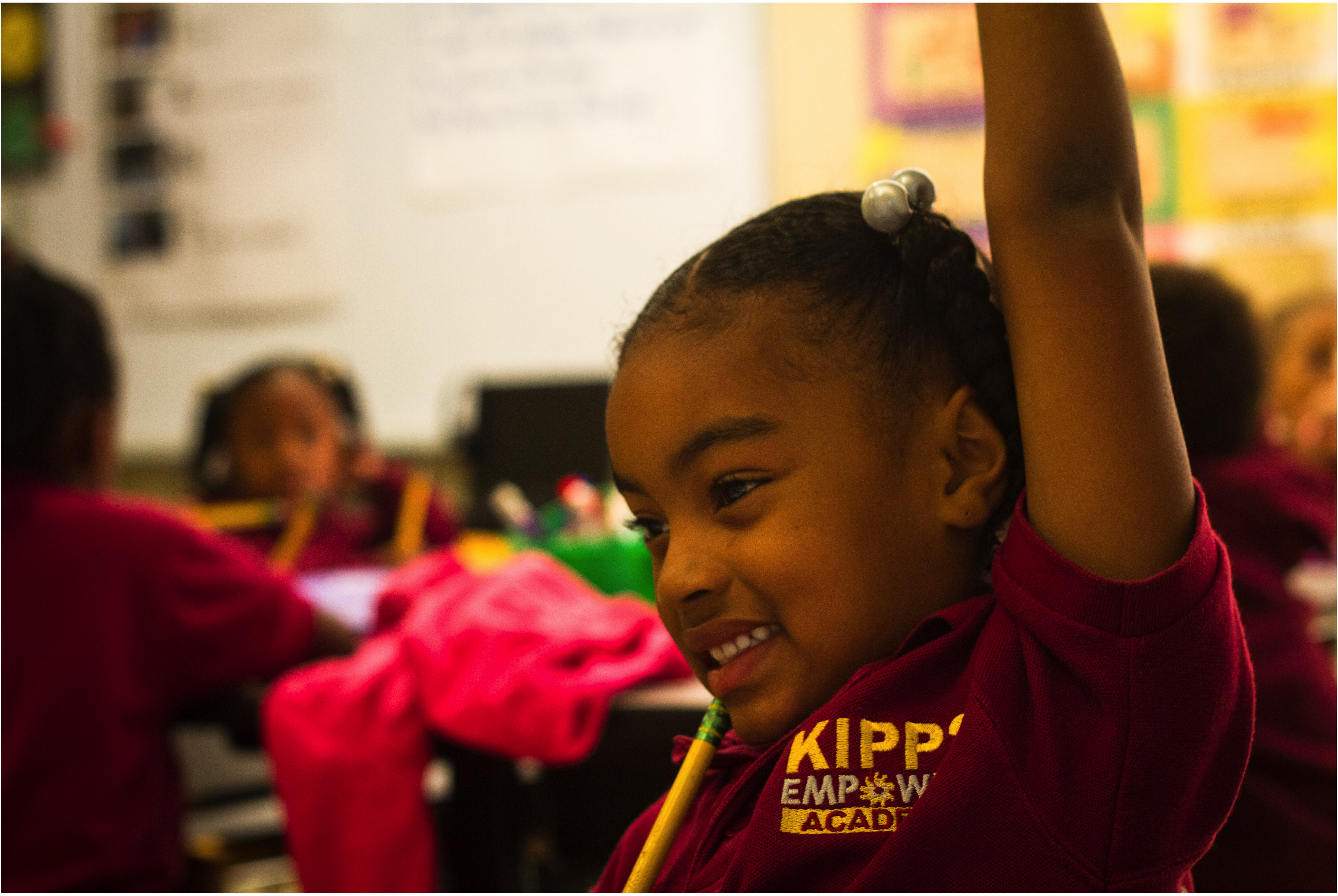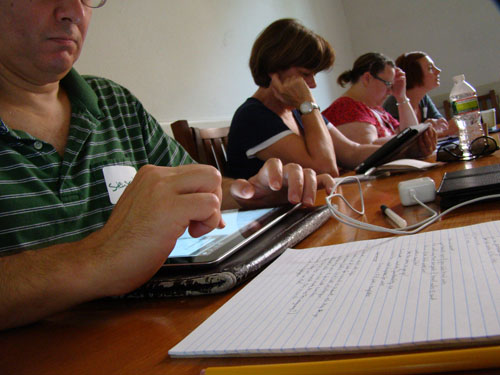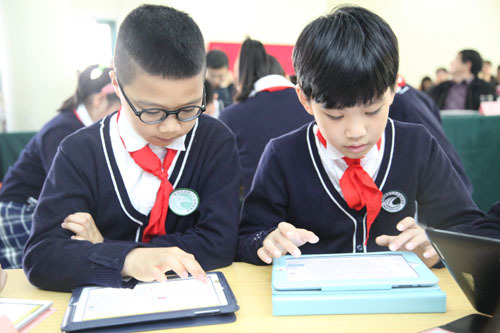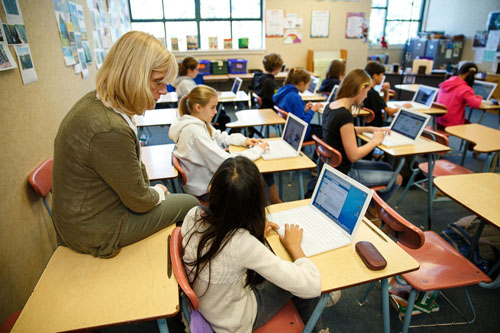Disrupt and Conquer! How far can technology go to ensuring no child gets left behind in school? In America’s race to eliminate the domestic and international achievement gaps, when will blended learning models be effective enough to disrupt the existing mainstream classroom system?
ב 2008, Michael Horn and Clayton M. Christensen co-authored the book שיבוש כיתה: איך Disruptive Innovation ישנה את הדרך לומדת העולם (McGraw-Hill). היום, as executive director of the Innosight Institute, Horn leads a team that studies the innovative ways technology is already transforming America’s education system into one in which every student, whatever his/her learning needs, can realize his/her full potential. Heather Staker is a senior research fellow for the Education Practice at Innosight Institute and the author of “The rise of K-12 blended learning: Profiles of emerging models.”
I asked Michael and Heather to share their insights on blended learning in this week’s edition of גלובל החיפוש לחינוך.
Heather, can you briefly describe the term “לימוד מעורב” and the four different types of models that serve as blended learning?
Blended learning is a formal education program that includes two components. The first is online delivery of content and instruction, where the students have at least some control over the time, מקום, נָתִיב, and/or pace of their learning. The second is that the students also attend a supervised brick-and-mortar location.
Through our research, we are observing four main models. The Rotation model is any time students rotate on a fixed schedule between online learning and other modalities for any given course. In the Flex model, student schedules are more fluid and content and instruction are delivered primarily by the Internet. The Self-Blend model is any time students take one or more courses entirely online to supplement their traditional courses. The Enriched-Virtual model involves students dividing their time within each course between attending campus and learning remotely online.
מיכאל, which of the four models do you believe is best?
None of the models is “הכי טוב” per se. בשלב זה, different schools will be able to put in place different models depending on their distinct needs and capabilities. Long term, I am most intrigued by the Flex model and believe that a combination of it and the Self-Blend model will likely represent the ideal educational model. The reason is that it most naturally puts students first so that all students can personalize and own their learning, which should mean more motivated students and more effective learning for all. The Flex model also creates natural and potentially rich opportunities for students to interact with other students to engage in challenging projects based on each student’s needs while preserving and potentially strengthening activities such as fitness and the arts.
Can you give me a real life example of the Flex model?
One of the best examples I have seen of the flex model was in Morgan Hill, קליפורניה. This is a district south of San Jose where about a third of its students are Hispanic and I believe over a third of its students are on free-and-reduced price lunch. The school is called the Silicon Valley Flex Academy – ציוני 6 דרך 12. As you walk into the school there are a couple of huge open spaces on either side where every student has his/her own office. In this space, each student has his/her own computer. The students are encouraged to decorate their own space with things they like (in the same way an adult might decorate an office at work). There are break out classrooms around the perimeter of the building. Here teachers are getting the data on how the kids are doing. Teachers can pull students into these break-out classrooms in very small groups. The teacher is then able to focus on a student’s individual issues. The teacher’s job is totally different in this arrangement. The fascinating thing was how much ownership the students have over their learning. They all knew exactly what was expected of them the entire year. They knew exactly how they were doing at any point. Their job was to learn the material. If they could get the work done during the school day there was no homework. So it was up to the individual students to make those decisions.
You say “the teacher’s job is totally different in this arrangement.” Were teachers learning on the job? Did you see any challenges in terms of educating teachers to use the Flex model?
The teachers I spoke to explained that they had been trained to do lesson planning, lectures to large groups of students and classroom management — none of which they were now doing. They explained that the adjustment was difficult. Training has not been built into the formal teacher training system for programs like this, and few are really thinking about it at the moment. עַכשָׁיו, the teacher is still doing teaching or tutoring when pulling students out into small groups for project-based work, but instead of this being determined by a pacing guide, this is now being determined by where the students are in their learning. What was so interesting was that in this model, teachers were able to do the tutoring and value enrichment work that teachers really like to do but don’t always get time to do in a classroom. One of the challenges the teachers mentioned was staying on top of scheduling. How do you keep track when you have students at different places in the curriculum? Those were tough decisions for teachers to make and they were, as you say, learning on the job.
What feedback did you get from the students in terms of being motivated to learn?
A number of students said to me: “Last night I was so bored. It was a three-day weekend and I decided to jump on my computer and do some math.” So I said, “You decided to jump on during the weekend and do math?” One student explained she thought it was fun to go on and get ahead a little bit. When I asked them if they ever did that in their old school model, they replied, “Not a chance!” When students own their learning, they feel responsible for it and motivated to do it. What they also appreciated was that the teacher was no longer there to “punish them” או “כיתה אותם”. Instead the teacher was there to help them reach their goal. This is much more of an environment built around success and motivation versus failure.
כמה רחוק יכול למידה מקוונת במערכות מעורבבים ללכת לכיוון פילוס המגרש לסוגים שונים של לומדים?
כרגע, נראה כי השמיים הוא הגבול, אבל אנחנו גם לא יודעים באופן מלא. Because online learning allows for modularity, it can in theory customize learning for each student’s individual needs. עם זאת, we are just in the early days of leveraging this as well as leveraging the enormous amounts of data we can receive in real-time about how a student is doing, which should allow us to adapt our approaches in exciting ways also in real time for each child. Today we’ve grasped the power of online learning to individualize for students, particularly those struggling ones, along the dimension of pace. But we haven’t come close to grasping the power to vary the paths for students.
Heather, what do you believe is the effectiveness of a blended learning school versus a brick and mortal school and versus a school that uses some tech but is not blended?
By many measures, America’s traditional brick-and-mortar classroom model is failing. התכנית להערכת סטודנטים בינלאומיים (PISA) ב 2009 ranked U.S. students as 14th in reading, 25th in math, and 17th in science compared to students in other industrialized countries. One cause of this underperformance is that the system is inflexible. Students move through grade levels in standardized batches and monolithic curricula, regardless of how each child learns best. School leaders often think technology will help. They add bling with electronic whiteboards, iPads, and digital lesson plans, but none of these on its own transforms the factory structure. The attraction of blending online learning into schools is that online learning allows for modularity. It can customize around the learning pathway each student follows, who teaches them, and how fast they master each concept. מספר בתי ספר כבר מספקים סביבות למידה-מעורבב מותאמות אישית מאוד, and the results are promising.
מיכאל, what challenges do you see with blended learning systems?
I think one challenge is executing it well. I think the changing role of the teacher is profoundly challenging. It is unfair that a huge percentage of what teachers have been taught is irrelevant in this learning environment. The beauty of this system is that computers are able to do what computers do well. Humans are freed up to do what humans do best.
I also think the assessment system that we have in place in schools is a problem for this learning system going forward. Assessment needs to be based on where each individual child started and then grew to and finally ended up in a particular year, versus a snapshot once a year view of an entire school.
For more information on the Innosight Institute: http://www.innosightinstitute.org/

Photos courtesy of Silicon Valley Flex Academy and Stern + שותפים.
בגלובל החיפוש לחינוך, להצטרף אליי ולמנהיגי מחשבה מוכרת בעולם כולל סר מייקל ברבר (בריטניה), DR. מיכאל בלוק (ארה"ב), DR. ליאון בוטשטיין (ארה"ב), פרופסור קליי כריסטנסן (ארה"ב), DR. לינדה דרלינג-Hammond (ארה"ב), DR. Madhav אוון (הודו), פרופ 'מיכאל Fullan (קנדה), פרופ 'הווארד גרדנר (ארה"ב), פרופ 'איבון הלמן (הולנד), פרופ 'קריסטין Helstad (נורווגיה), ז'אן הנדריקסון (ארה"ב), פרופ 'רוז Hipkins (ניו זילנד), פרופ 'קורנליה הוגלנד (קנדה), גברת. שנטל קאופמן (בלגיה), DR. Eija Kauppinen (פינלנד), מזכיר המדינה Tapio Kosunen (פינלנד), פרופ 'דומיניק לפונטיין (בלגיה), פרופ 'יו לאודר (בריטניה), פרופ 'בן לוין (קנדה), פרופ 'בארי McGaw (אוסטרליה), שיב נדאר (הודו), פרופ 'R. נטריגין (הודו), DR. PAK NG (סינגפור), DR. דניז אפיפיור (ארה"ב), שרידהר ךאג'גופלן (הודו), DR. דיאן ראוויטש (ארה"ב), סר קן רובינסון (בריטניה), פרופ Pasi Sahlberg (פינלנד), אנדריאס שלייכר (PISA, OECD), DR. אנתוני סלדון (בריטניה), DR. דוד שפר (ארה"ב), DR. קירסטן Immersive Are (נורווגיה), קנצלר סטיבן ספאן (ארה"ב), איב Theze (Lycee Francais ארה"ב), פרופ 'צ'רלס Ungerleider (קנדה), פרופ 'טוני וגנר (ארה"ב), סר דייוויד ווטסון (בריטניה), פרופסור דילן Wiliam (בריטניה), DR. מארק Wormald (בריטניה), פרופ 'תיאו Wubbels (הולנד), פרופ 'מייקל יאנג (בריטניה), ופרופ 'Minxuan ג'אנג (סין) כפי שהם לחקור שאלות חינוך תמונה הגדולות שכל המדינות מתמודדות היום. גלובל החיפוש לחינוך עמוד קהילה
C. M. רובין הוא המחבר שתי סדרות מקוונות רבים קוראות שלהיא קיבלה 2011 הפרס אפטון סינקלר, “גלובל החיפוש לחינוך” ו “איך וויל אנחנו קראו?” היא גם מחברם של שלושה ספרים רבי מכר, כולל אליס בארץ הפלאות Real.






תגובות אחרונות